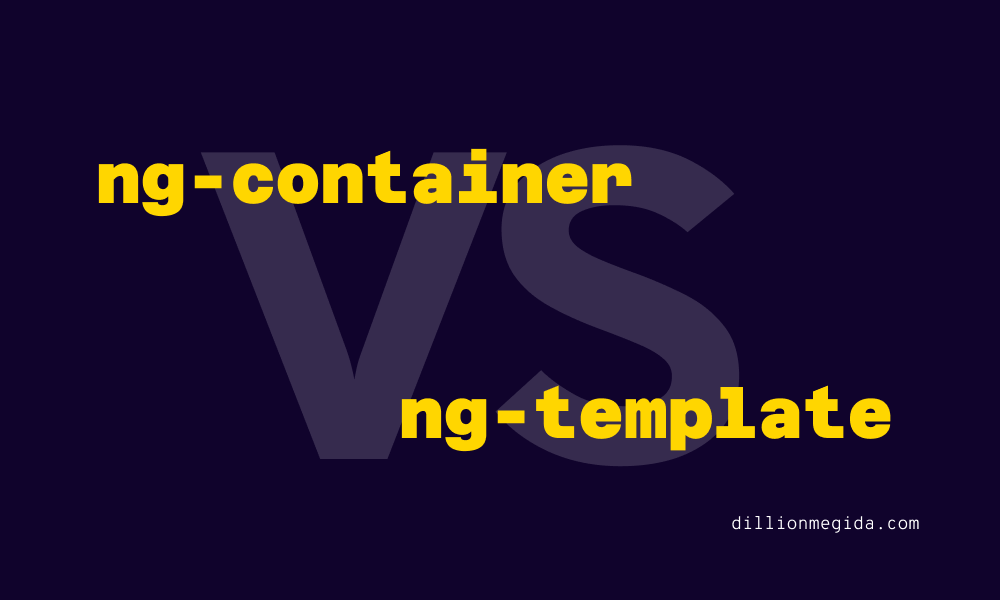Difference between ng-container and ng-template in Angular | What they are and when to use them
March 5th, 2022

Here's a video if you'd prefer that: https://youtu.be/LsHQV5VMdFc
ng-container and ng-template are Angular elements that work like containers with HTML elements. However, they have different purposes or use cases.
ng-container
If you're familiar with React, you may know the Fragment React component. This component is used when you do not want to add an extra HTML element to the DOM (like a div or span), but you want a wrapper around children components.
ng-containers work just like that, and it also accepts Angular structural directives (ngIf, ngFor, e.t.c). They are elements that can serve as wrappers but do not add an extra element to the DOM.
Let's see an example where you might want to use this:
// app.component.ts
export class AppComponent {
products = [
{
id: "iphone",
name: "iPhone",
price: "599",
},
{
id: "samsung",
name: "Samsung",
price: "699",
},
{
name: "Pixel",
price: "599",
},
]
}<!-- app.component.html -->
<div *ngFor="let product of products">
<span>{{ product.name }}</span>
</div>Here, in the HTML, we can loop through the products array, and display the product's name in a span tag.
But what if you want to render the div tag conditionally; that is, if the product has an id property? Then, we can use the *ngIf structural directive, maybe like this:
<div *ngFor="let product of products" *ngIf="product.id">
<span>{{ product.name }}</span>
</div>But, this will throw an error.
As you may already know, in Angular, you cannot apply two or more structural directives on an element. Your next solution may be:
<div *ngFor="let product of products">
<div *ngIf="product.id">
<span>{{ product.name }}</span>
</div>
</div>This code would work, but now you're introducing a div element that you may not need.
We can solve this with ng-container like so:
<ng-container *ngFor="let product of products">
<div *ngIf="product.id">
<span>{{ product.name }}</span>
</div>
</ng-container>With this, the DOM won't include the ng-container, so we're not adding an extra element that we do not need. Angular will render the container element as a comment in the DOM. And if you need to use another structural directive before the div element, you can use more ng-containers.
ng-template
Think of ng-template as a template that defines a composition of elements (the template content), but Angular does not render it by default. It only does when you specify it to be rendered.
With the following code:
<h1>Hello</h1>
<ng-template>
<h2>How are you</h2>
</ng-template>In the HMTL source code in the browser, you'll find the second part commented like this:
<h1 _ngcontent-agr-c11>Hello</h1>
<!-- -->It is not rendered; it's only defined in the source code.
Let's look at a use case for this element:
<ng-template #noProducts>
<p>There are no products in this store</p>
</ng-template>Above, we've defined a template with the name noProducts. In this example, we'll render it to the DOM if there are no products, like this:
<ng-container *ngIf="products.length > 0; else noProducts">
<ng-container *ngFor="let product of products">
<div *ngIf="product.id">
<span>{{ product.name }}</span>
</div>
</ng-container>
</ng-container>
<ng-template #noProducts>
<p>There are no products in this store</p>
</ng-template>The template will never be rendered until it has to be.
We can store a piece of UI code with a template element and apply it to the DOM conditionally.
Difference between ng-container and ng-template
ng-container serves as a container for elements which can also accept structural directives but is not rendered to the DOM, while ng-template allows you to create template content that is not rendered until you specifically (conditionally or directly) add it to the DOM.
In this article, we've seen how the ng-container and ng-template Angular elements work, their differences, and when to use them. If you have questions, you can reach out to me on Twitter - @iamdillion
Watch the video version of this here: ng-container vs ng-template
